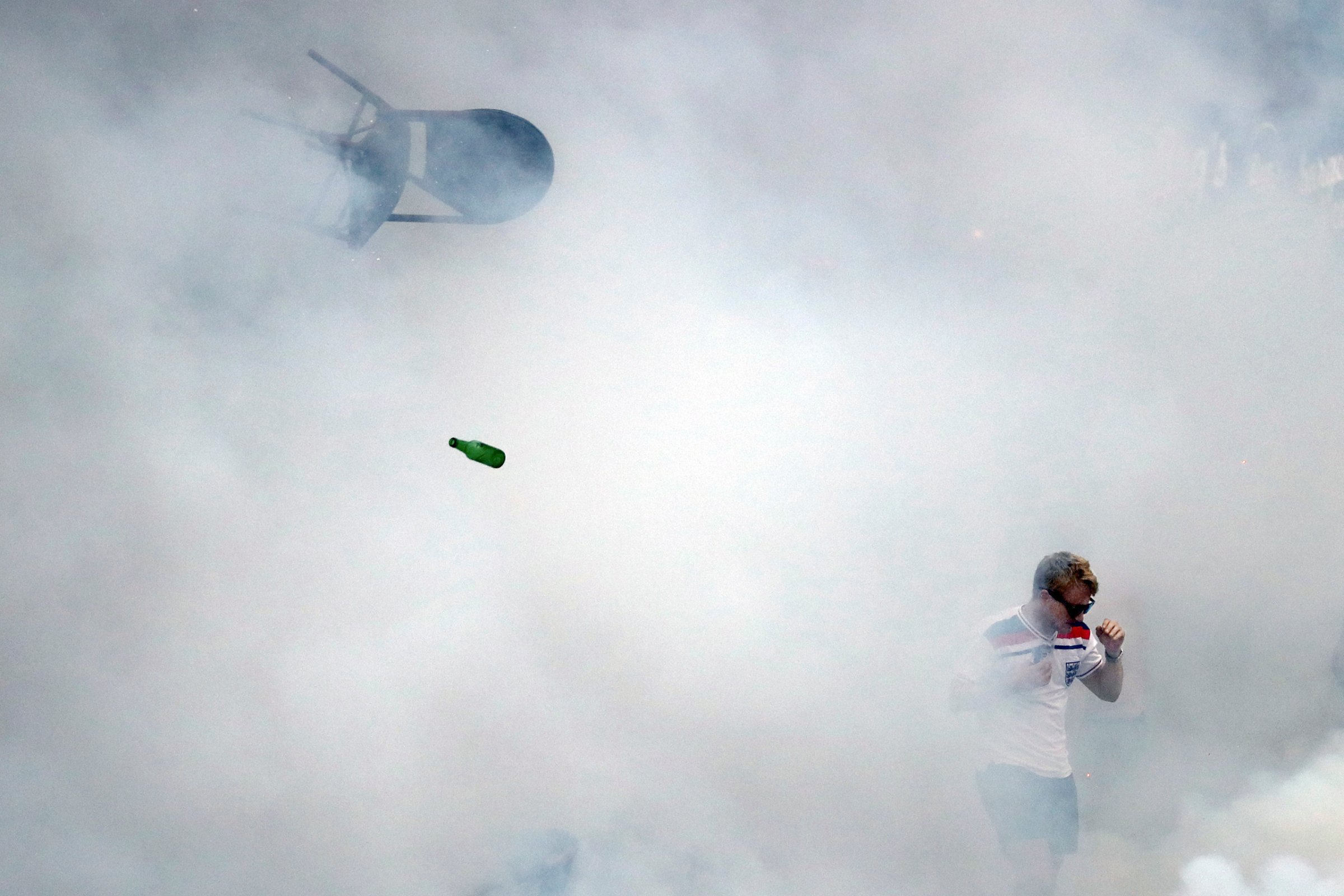
The photograph would deserve a place on somebody’s wall were the context not as bleak.
In focus is an England supporter, his sunglasses no protection from the cloud of teargas, clasping a bottle of beer while reeling from the chaos around him. In the foreground rests a pile of scattered debris; a ripped-open pack of Heineken and similar ephemera. And most spectacularly, caught in mid-motion through the smoke, a chair flying through the air, its destination a lingering question.
To many in the U.K. and beyond, the scenes during the European Championships seemed like a throwback to a time when football matches were commonly taken as a byword for violence. The puzzle, as English and Russian supporters clashed repeatedly in Marseille and in Lille these past days, was why this should happen again now.
The primary burden of responsibility has been placed on the Russians, who were given a suspended disqualification from the tournament after a group of their supporters charged their England counterparts after the sides’ 1-1 draw last Saturday. There is little doubt that the estimated 200 Russian hooligans in Marseille were highly organized, and came for a fight. But the English are far from blameless themselves, and their role in the brutal skirmishes on the streets of Marseille with rival fans, locals and police was also criticised heavily by governing body UEFA.
Trouble seems to follow England’s supporters around, though, and perhaps this resurgence is a case of reaping what you sow. English fans abroad, whether of clubs or country, have a lengthy rap sheet and the nadir came at the 1985 European Cup final when Liverpool supporters charged at Juventus followers inside the Belgian national stadium, Heysel. There were 39 deaths and the ramifications, which saw the country’s clubs banned from European football for five years, were severe.
But still, episodes of hooliganism would return periodically — usually during tournaments in Europe. During the 1998 World Cup, riots between English and Tunisian supporters on the same streets as the violence this week led to some of Marseille’s local government requesting compensation for the city.
Two years later there were problems at Euro 2000, held in Holland and Belgium, with over 500 arrests after rioting in Brussels and Charleroi before a game in Germany. England were threatened with elimination themselves that year; the 2006 World Cup brought fresh trouble, though, with one incident seeing 122 arrested in Stuttgart.
Authorities in the U.K. have attempted to clean up their supporters’ acts; since 2000, known troublemakers have been made to hand in their passports before a tournament begins. But England’s reputation precedes it. The country’s hooligan elements of the past, largely drawn from far-right groups such as the neo-Nazi Combat 18, remain an inspiration for similarly-minded organisations elsewhere, particularly around Eastern Europe. “The English always say they are the main football hooligans,” one Russian supporter told AFP. “We are going to fight the English.”
That’s not to say England supporters are model citizens. An observer this week would not have to look far to see leering and aggression, hear the chants recalling World War Two, and see the excessive drinking. They may be the actions of a minority, but they are not hard to spot. The drunken posturing is more than enough to provoke reactions from local police, and to goad more determined opposition into action.
Then there’s the specter of nationalism, which has taken root in Europe since the crash of 2008, and especially since the ongoing refugee crisis began. England supporters could be heard in Marseille chanting in favour of exiting the European Union, days before the UK referendum on the question.
Right-wing influences in Russia, however, are far more potent and the hooligan elements may bear some relationship to the chest-beating image of Vladimir Putin’s government. That impression was certainly not dulled when Igor Lebedev, an MP and the deputy chairman of the Russian parliament, tweeted: “In nine out of 10 cases football fans go to fight, and that’s normal. The lads defended the honour of their country and did not let English fans desecrate our motherland.”
The clashes in Lille caused less damage, breaking out in pockets and almost certainly being diluted by the joyful scenes sparked among locals by France’s last-gasp win over Albania. But the overall picture remains the same. That image, featured in this week’s issue of TIME, might show a fan smothered in smoke but the concern about this month’s very public lurch back into football savagery is crystal clear.
More Must-Reads From TIME
- The 100 Most Influential People of 2024
- The Revolution of Yulia Navalnaya
- 6 Compliments That Land Every Time
- What's the Deal With the Bitcoin Halving?
- If You're Dating Right Now , You're Brave: Column
- The AI That Could Heal a Divided Internet
- Fallout Is a Brilliant Model for the Future of Video Game Adaptations
- Want Weekly Recs on What to Watch, Read, and More? Sign Up for Worth Your Time
Write to Nick Ames / Lille, France at ames.nick@gmail.com